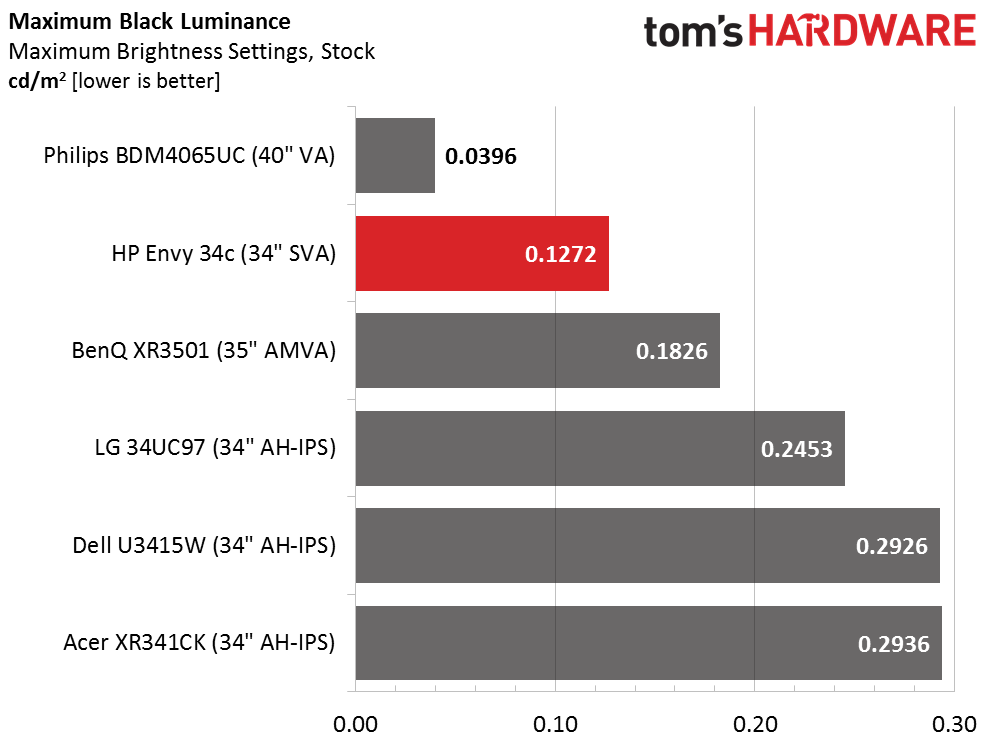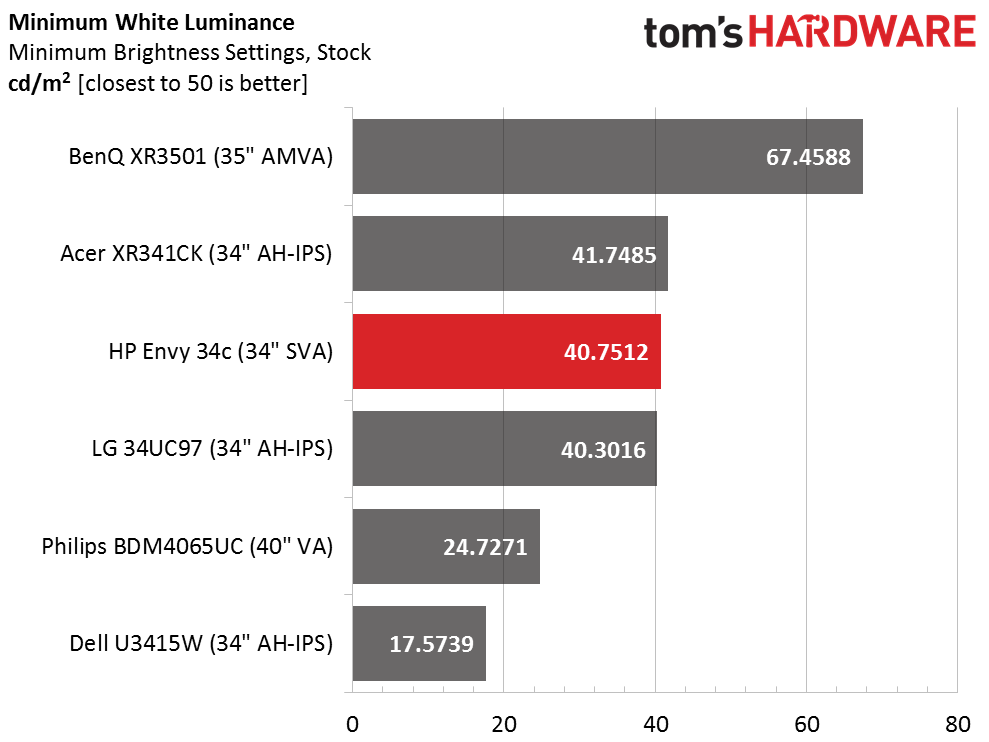HP Envy 34c Monitor Review
HP’s new 34-inch curved Envy 34c sports a high-contrast SVA panel and DTS-tuned speakers; features that set it apart from the competition. Today we check out its performance in our benchmark suite.
Why you can trust Tom's Hardware
Brightness And Contrast
To read about our monitor tests in-depth, please check out Display Testing Explained: How We Test Monitors and TVs. Brightness and Contrast testing is covered on page two.
Uncalibrated – Maximum Backlight Level
Including the Envy 34c we’ve reviewed five curved screens to-date: BenQ’s XR3501, Acer’s XR341CK, Dell’s U3415W and LG’s 34UC97. To bring the group to six we’ve included the Philips BDM4065UC which is also based on VA technology.
Out of the box, we could only get around 280cd/m2 peak brightness which is well below HP’s spec of 350. By changing the color mode to Native and the Quick View to Custom, we upped that figure to 292.6519cd/m2. You get extra output but whites look a little green and there’s no way to fix the color errors. The Envy 34c offers enough light for just about any application.
This is the fun part of measuring VA panels: the awesome black levels. Philips will probably hold the record for a while but HP is the best of the rest at .1272cd/m2.
Here’s why we love VA monitors. The contrast is far above that of IPS or TN displays. It has a significant impact on image quality making the picture far more 3D-like. Colors look more saturated and vivid as well. The Envy 34c is one great-looking screen.
Uncalibrated – Minimum Backlight Level
The minimum output level is a tad low but useable at 40.7512cd/m2. Please refer to our brightness settings on the previous page to find your preferred level.
The Dell moves into second place by virtue of its super-dim minimum backlight. Its contrast isn’t any higher than other IPS screens.
Get Tom's Hardware's best news and in-depth reviews, straight to your inbox.
The Envy 34c’s contrast drops 18 percent as you lower the backlight. Since the ratio is so high you won’t notice a major shift in image depth but it’s not as consistent as the other monitors here.
After Calibration to 200cd/m2
Calibration preserves the excellent black level at a super-low .1015cd/m2. It can’t really get much better unless you put that jumbo Philips on your desk.
The Envy 34c posts the second-best calibrated contrast we’ve ever recorded. If this doesn’t convince you to consider a VA panel for your next monitor, we don’t know what will.
ANSI Contrast Ratio
ANSI contrast measures only a scant seven-percent below the calibrated on/off number. There’s little doubt that HP is using a quality panel part here. This test result means real-world content will have a lot more depth and dimension than what you’ll see on an IPS or TN screen. All we need now are more product choices.
Current page: Brightness And Contrast
Prev Page OSD Setup And Calibration Next Page Grayscale Tracking And Gamma Response
Christian Eberle is a Contributing Editor for Tom's Hardware US. He's a veteran reviewer of A/V equipment, specializing in monitors. Christian began his obsession with tech when he built his first PC in 1991, a 286 running DOS 3.0 at a blazing 12MHz. In 2006, he undertook training from the Imaging Science Foundation in video calibration and testing and thus started a passion for precise imaging that persists to this day. He is also a professional musician with a degree from the New England Conservatory as a classical bassoonist which he used to good effect as a performer with the West Point Army Band from 1987 to 2013. He enjoys watching movies and listening to high-end audio in his custom-built home theater and can be seen riding trails near his home on a race-ready ICE VTX recumbent trike. Christian enjoys the endless summer in Florida where he lives with his wife and Chihuahua and plays with orchestras around the state.
-
HideOut I'd like a 2K version of one of these things. Speakers not needed. I have a DTS 5.1 in the office already. But my GPU isn't going to drive a 4k well. Even 2K will be hard but its cheaper to upgrade to a 2K capable card.Reply -
Shankovich Guys for this price, if you're not going to go above 60 Hz, as I see this is a more a workstation thing, 10-bit colour at least ;-;Reply -
picture_perfect ReplyI'd like a 2K version of one of these things. my GPU isn't going to drive a 4k well.
Yea. It's less than 4K but it's still too much. Lower frame rates are innately blurry on LCD, which makes spending money on quick pixel response times pointless. Also throw those low input lag numbers out the window when frame rendering takes this long. And of course enjoy some low frame rate jitters (with or without G-sync). I would spend another grand on dual gtx980s to get this monitor working like expected...well no, actually I wouldn't. -
MetzMan007 Free Sync, Almost makes me want to switch from Nvidia to ATI. Very Good looking screen, Almost Sexy in its own way.Reply -
Merry_Blind I'd really like to see a VA panel designed for gaming, with lowest input lag and response time possible. To me it's the technology that looks the best between it, TN, and IPS, but it seems to be the worst in terms of speed... which isn't good for gaming.Reply











